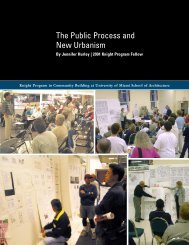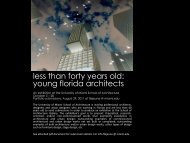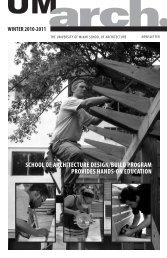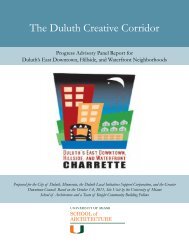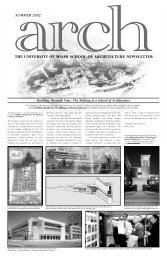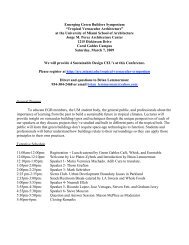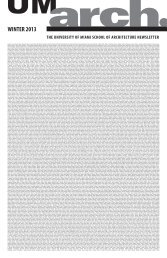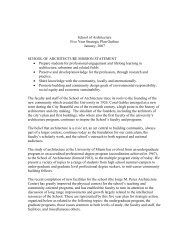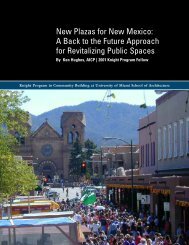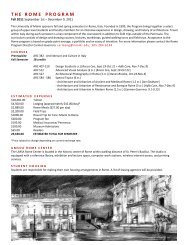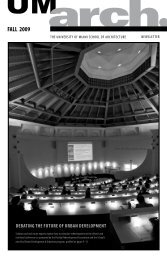FIVE YEAR STRATEGIC PLAN - SPRING 2010 REVISED - April 8 ...
FIVE YEAR STRATEGIC PLAN - SPRING 2010 REVISED - April 8 ...
FIVE YEAR STRATEGIC PLAN - SPRING 2010 REVISED - April 8 ...
You also want an ePaper? Increase the reach of your titles
YUMPU automatically turns print PDFs into web optimized ePapers that Google loves.
<strong>FIVE</strong> <strong>YEAR</strong> <strong>STRATEGIC</strong> <strong>PLAN</strong> - <strong>SPRING</strong> <strong>2010</strong><strong>REVISED</strong> - <strong>April</strong> 8, <strong>2010</strong>SCHOOL OF ARCHITECTURE MISSION STATEMENTPrepare students for professional engagement and lifelong learning in architecture,urbanism and related fieldsPreserve and develop knowledge for the profession, through research and practice.Share knowledge with the community, locally and internationally.Promote building and community design goals of environmental responsibility, socialequity and economic sustainability.BACKGROUNDThe School of Architecture is rooted in the founding of the new community that created theUniversity in 1926. Coral Gables emerged as a new town during the City Beautiful era of thetwentieth century, a high point in the history of architecture and city making. The idealism ofthe founders, including the architects of the city’s plan and first buildings, who where also thefirst faculty of the university’s architecture program, continues to inspire the School’s facultyand programs. The belief that architecture is a civic art, an act central to building communityand always part of a larger context, is the foundation for our curriculum, for the faculty’sscholarly work, and for the school’s outreach to both regional and national audiences.The study of architecture at the University of Miami has evolved from an undergraduate major toan accredited professional degree program (1967), to the establishment of the School ofArchitecture (1983), to the multiple programs and national reputation of today. We present avariety of topics to a range of students from high school summer-campers to under-graduate andgraduate professional degree seekers, to mid-career community builders.2007 <strong>STRATEGIC</strong> <strong>PLAN</strong>The Jorge M. Perez Architecture Center’s opening five years ago has provided impetus forprofessional program curriculum improvements and for the establishment of new programs.These were among the School’s 2007 Strategic Plan goals. Most of the 2007 goals – those notrequiring major funding – have been achieved:established four new programs: B.Arch/MBA; BSAE/M.Arch; MRED+U (Real EstateDevelopment and Urbanism); Certificate in Historic Preservation;
improved undergraduate graduation rate from 59% (2007) to 73% (2009) improved quality of entering graduates: average GRE up 34 points since last year. increased financial aid for graduate students instituted annual semester in Rome for graduate students (undergraduate program 20years old) increased faculty recognition (4 books published with national and international pressesin 2009) improved Fabrication Lab facilities with dust collector and new machinery includinglaser cutter re-designed School website and recruiting materials<strong>2010</strong> <strong>STRATEGIC</strong> <strong>PLAN</strong>The School’s <strong>2010</strong> goals are organized as a framework for the approaching campaign, under thetopics of curriculum, students, faculty and staff, facilities and other support.Curriculum:The recent curriculum improvement and expansion continues at a steady rate within the visionthat has earned the School its international reputation. The changing context of professionalpractice and program accreditation serve as a guide to evolution, as does the faculty’s ongoingdiscussions of the best way to fulfill our mission. Revise professional curriculum (B.Arch., M.Arch.) to generate a semester by semesterchecklist of knowledge and skills, and to reflect new accreditation criteria. (budgetneutral, underway) Reposition Master of Town and Suburb Design as Master of Urban Design withrevised curriculum to reflect evolving economic and development conditions in the U.S.and around the world (budget neutral, underway) Review Master of Architecture in Research to expand opportunities for crossdisciplinary studies and research in architecture, urban design, real estate developmentand with other University departments (budget neutral, underway) Develop new certificate programs by consolidating curriculum offerings in seven areasof faculty expertise, to assist in student recruitment and to promote faculty recognition:(budget neutral, underway)o historic preservation (certificate program established)o health care designo new urbanismo real estate developmento mid-century modern architectureo classical architectureo sub-tropical and tropical design Develop courses to study architecture and urban design for university studentsoutside School of Architecture. (budget neutral, underway)
Explore off-site B.Arch. transfer program in Orlando and Nassau; preliminaryinvestigation shows significant revenue could be generated in these underserved marketlocations. (budget neutral, underway)Explore establishment of a Ph.D. Urban Design to extend School’s research capacityand reputation; growing inquiries about advanced study and research in School’s focusareas, and this year’s presence of several dissertation level Ph.D. candidates from otherinstitutions, have increased faculty interest in providing a doctoral program. (budgetneutral study; program funding sources to be explored, also)Students:Student quality has been increasing, with the School’s SAT average among the top in theUniversity. Competing with aspirational peer schools for students requires constant improvementin programs and facilities as well as in opportunities for experience and increased financial aidopportunities. Increase quantity and quality of applicants and enrollment in M.Arch, MUD andMRED+U programs (depends on additional scholarship funding) Increase recruitment of graduate students from abroad through increased promotionof programs internationally and development of new exchange and collaborationprograms (budget neutral) Increase improvement trajectory for all programs: increase test score averages (dependson additional scholarship funding) Institute a fifth year teaching assistantship for best B.Arch. students (budget neutral) Increase scholarships for upper level undergraduates and graduate students, in particularto assist in final semester (campaign goal $1million) Establish Rome scholarship to enable more students to participate in semester programabroad (campaign goal $500,000.00)Faculty and Staff:After several years of attending to curriculum improvements and additions, it is clear that theSchool’s next strategic focus must be on faculty resources, in particular with regard to quantityand topical distribution of full-time faculty, and to teaching load as it relates to expectations forresearch. Add three new full-time faculty positions; current ratio of full to part-time faculty isinadequate particularly in undergraduate core classes. (including decrease in part-timefaculty, this requires annual budget increase of $250,000.00, to be derived from$5.5 million campaign goal for faculty chairs) Reduce full-time teaching loads to reflect that of peer schools; for faculty producingscholarly work, a reduction from 18 credits/year to 15 (or 12 in the case of the historians)will require additional full-time faculty to maintain overall credit hours (annual budgetincrease to be determined, to be derived from campaign goal for faculty chairs) Add two distinguished part-time visiting studio faculty positions forundergraduate/graduate upper-level studios (annual budget increase to be determined, tobe derived from campaign goal for faculty chairs) Add staff writer/publications coordinator to manage increasing need forcommunications, symposium assistance, recruitment material and website. ($80,000.00addition to School budget, $1.5 million endowment)
Seek dedicated funding for the Center for Urban and Community Design (CUCD) tosupport a staff position ($50,000.00 annually, requires a $1 million endowment)Facilities and other support:The future of the School’s facilities revolves around the preservation and restoration of thehistoric Marion Manley buildings (Bldgs. 48 & 49), part of the University’s preservation goals.Minimally renovated in 1983, these buildings require major attention to ensure their longevityand their continuing usefulness for the School’s programs. Three program areas they will neverbe able to accommodate remain as pressing needs: unified studio space for the undergraduate andgraduate core design studios; a larger fabrication lab to accommodate new hi-tech fabricationmachinery; and library facilities to enable the transfer of the architecture collection from Richter,and its growth from 40,000 to 100,000 volumes, Complete master plan for School facilities, including new library and consolidatedstudio space for first and second year students ($50,000.00 School plant funds) Design, fund and build 12,000SF new studio space ($4.5 million: $0.5 million in hand,$4 million campaign goal) Design, fund and restore Buildings 48 and 49, including additions for handicappedaccess and current building code requirements($10 million - $500,000.00 grants, $9.5M philanthropy and University) Add fabrication and prototyping equipment to Fabrication Lab ($50,000.00 – specialprograms revenues) Convene second fall MRED+U Council meeting in conjunction with the School ofBusiness Administration’s MBA-Real Estate Council and create University–wide RealEstate Programs Board including the Law School LLM Program in Real PropertyDevelopment (School budget) Pursue the establishment of a University-wide Real Estate Center to pursue multiplefundraising objectives (jointly with School of Business Administration) Add software and online database subscriptions and library holdings to supportcourses and research for program in real estate development and urbanism, new urbanismand preservation ($50,000.00 campaign goal) Seek dedicated funding to establish annual sponsored capstone charrette for MRED+Uand MUD students ($25,000.00 annually, requires a $500,000 endowment) Initiate Continuing Education Units (CEU’s) for travel study and computer courses(revenue generator)




